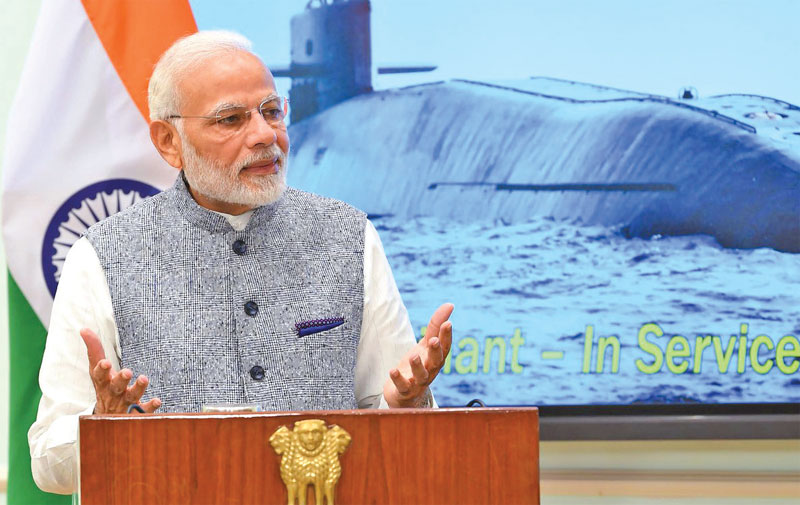With its growing fleet of SSBNs, PLAN has emerged as the most potent force in the region
Cdr S. Shrikumar (retd)
The term ‘Indo-Pacific’, was originally meant to define a bio-geographic region of the seas, comprising the tropical waters of the Indian Ocean, the Western and Central Pacific Ocean, and the seas connecting the two oceans in the general area of China and Indonesia. The temperate and polar regions of the Indian and Pacific oceans and the eastern Pacific along the coast of the Americas do not form a part of the Indo-Pacific.

Over the last decade and a half, the frequency of the usage of the term, ‘Indo-Pacific’, has grown multi-fold in the geopolitical context. However, the first usage of the term ‘Indo-Pacific’, in geopolitical conversations, is from a much earlier time. It was, reportedly, first used by the German geopolitician Karl Haushofer, in the 1920s, in his academic work ‘Indopazifischen Raum’.
Interestingly, the first author to use the term in the context of the current ‘security’ linkage between the two oceans, is thought to be Gurpreet Khurana--in an article authored by him in the Strategic Analysis Journal (2007). In the article, Khurana used the term ‘Indo-Pacific’ to define the maritime space stretching from the littorals of East Africa across the Indian Ocean and Western Pacific Ocean to the littorals of East Asia.
The international order in the Indo-Pacific--dubbed as the world’s new geopolitical centre of gravity--has, of late, attracted a lot of attention. The increased interest in the region is a result of the multi-layered maritime competition fuelled by the rise in the military and economic might of China, the presence in the region of several nuclear-capable nations (India, China, Pakistan and North Korea), US allies (Japan, South Korea and Australia) and the ASEAN--all with competing geopolitical and economic interests. Also in the mix, is a deep concern, among the region’s nations, over the security and control of arguably the world’s most important maritime trading channel--the Malacca Strait.
China’s Nuclear Doctrine
Nuclear weapons play an important but restricted role in China’s defence plans. China adopted the nuclear ‘No First Use’ (NFU) policy in 1964. Since then, China has been steadfast in its adherence to the NFU commitment in the planning of its nuclear force structure and operational doctrine. China often presents its small, but survivable nuclear force, as evidence of the limited role nuclear weapons are meant to play in China’s nuclear operations doctrine. Within the nuclear policy and decision-making circles in China, possession of a reliable retaliatory capability has come to be accepted as an adequate safeguard against nuclear coercion.
For its second-strike capability, China, for long, has preferred to rely primarily on its land-based strategic missile force. Till recently, it seemed that barring major technological advancements in missile defence, with the potential to reduce the effectiveness of China’s land-based missile force, China would continue to principally rely on the land-based leg of its nuclear deterrence triad.
Consistent with its NFU policy, the People’s Liberation Army (PLA) is guided by two key principles in its nuclear counter-strike strategy:
- Ensure secure protection of nuclear weapons and delivery systems to ride out and survive an adversary’s attempt at a crippling nuclear first strike. To this end, China has invested in the mobility, penetrability, and concealment of its delivery systems.
- Targeted nuclear counter strikes--to inflict unacceptable damage by striking strategic targets, in retaliation to a first strike by an adversary.
Typically, commitment to the NFU policy would require the stockpiling of a large nuclear arsenal. However, China’s official position is to eschew an arms race--choosing instead, to maintain a lean arsenal of assets with reliable and robust retaliatory capability. Accordingly, in the development of its nuclear arsenal, China, maintains a lean arsenal, possessing an estimated 290 warheads versus approximately 3,800 warheads in the US arsenal.
Chinese strategists repeatedly emphasise China’s strategic depth (physical separation between the battle frontline and the centres of military production/ cities) as the reason for their faith in their restrained nuclear strategy.
China’s Civil-Military Balance
The Politburo and the Central Military Commission control the formulation of China’s nuclear strategy. Consistent with its stated posture of nuclear weapon use only as a retaliatory measure, and to obviate the possibility of an accidental or unauthorised launch, China’s nuclear warheads are stored separately from the delivery systems. Also, the nuclear weapon systems are kept off-alert during peacetime.
Given China’s highly centralised command and control arrangements and warhead handling practices, the necessity of developing an operational doctrine for SSBNs, that necessitates the devolution of greater autonomy and authority to submarine commanders, poses a greater challenge to China than it does for other nations.
The highly centralised command and control structure presents China with a unique dilemma when operating air and sea-based nuclear deterrents. It is not practical, for example, for SSBNs that are deployed on Continuous At Sea Deterrent (CASD) patrols to operate with unmated warheads and delivery systems.
You must be logged in to view this content.

